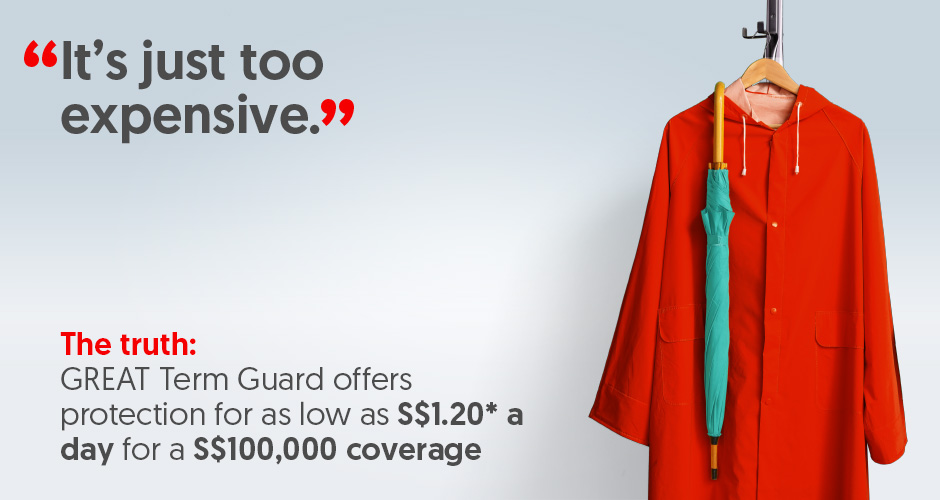4 common myths about term life insurance you need to know
4 common myths about term life insurance you need to know
Dispel the myths and learn how GREAT Term Guard can protect what matters most to you!
1. Myth: “It’s a waste if I don’t make any claim.”

GREAT Term Guard refunds ALL your premiums if you do not make any claim during your policy term, which is until age 65 (next birthday). Does it sound too good to be true? Let us break it down for you. When the policy starts, you pay your premiums at the frequency you selected, up till you turn 65. If no claims are made, you will get a full refund of your premiums and the policy will then be terminated!
2. Myth: “It doesn’t benefit me while I’m alive.”

GREAT Term Guard protects you with extensive coverage against 53 critical illnesses, ensuring peace of mind. It offers comprehensive coverage for total and permanent disability, terminal illnesses as well as various critical illnesses.
3. Myth: “It’s just too expensive.”

GREAT Term Guard provides protection for as low as just S$1.20* a day for S$100,000 coverage. You can choose between 2 coverage options – S$100,000 or S$200,000 – to best suit your needs. Secure your rate while you’re still young and enjoy affordable peace of mind.
*Daily rate is based on age 19 next birthday, male, non-smoker with the annual premium of S$435.40, divided by 365 days and rounded up to the nearest cent.
4. Myth: “Applying for a policy is time-consuming.”

Applying for GREAT Term Guard is quick and easy, taking no more than 10 minutes online! Thanks to the OCBC Digital app’s streamlined application process, securing your coverage is a breeze. Don’t wait – sign up now to protect your future!
Apply for GREAT Term Guard today and get up to a $500 one-time cash reward
Alternatively, you can get us to contact you.
Do not have the app?
Download on Apple app store
Download on Google Play
Download on AppGallery
General Disclaimer
This advertisement has not been reviewed by the Monetary Authority of Singapore.
- Any opinions or views of third parties expressed in this document are those of the third parties identified, and do not represent views of Oversea-Chinese Banking Corporation Limited (“OCBC Bank”, “us”, “we” or “our”).
- This information is intended for general circulation and / or discussion purposes only. It does not consider the specific investment objectives, financial situation or needs of any particular person.
- Before you make an investment, please seek advice from your Relationship Manager regarding the suitability of any investment product taking into account your specific investment objectives, financial situation or particular needs.
- If you choose not to do so, you should consider if the investment product is suitable for you, and conduct your own assessments and due diligence on the investment product.
- We are not making an offer, solicit to buy or sell or subscribe for any security or financial instrument, enter into any transaction or participate in any trading or investment strategy with you through this document. Nothing in this document shall be deemed as an offer or solicitation to buy or sell or subscribe for any security or financial instrument or to enter into any transaction or to participate in any particular trading or investment strategy.
- No representation or warranty whatsoever in respect of any information provided herein is given by OCBC Bank and it should not be relied upon as such. OCBC Bank does not undertake an obligation to update the information or to correct any inaccuracy that may become apparent at a later time. All information presented is subject to change without notice.
- OCBC Bank shall not be responsible or liable for any loss or damage whatsoever arising directly or indirectly howsoever in connection with or as a result of any person acting on any information provided herein.
- Investments are subject to investment risks, including the possible loss of the principal amount invested. The information provided herein may contain projections or other forward-looking statements regarding future events or future performance of countries, assets, markets or companies. Actual events or results may differ materially. Past performance figures, predictions or projections are not necessarily indicative of future or likely performance.
- Any reference to a company, financial product or asset class is used for illustrative purposes and does not represent our recommendation in any way.
- The information in and contents of this document may not be reproduced or disseminated in whole or in part without the Bank’s written consent.
- OCBC Bank, its related companies, and their respective directors and/or employees (collectively “Related Persons”) may, or might have in the future, interests in the investment products or the issuers mentioned herein. Such interests include effecting transactions in such investment products, and providing broking, investment banking and other financial services to such issuers. OCBC Bank and its Related Persons may also be related to, and receive fees from, providers of such investment products.
- You must read the Offer Document/Indicative Term Sheet/Product Highlight Sheet before deciding whether or not to purchase the investment product, copies of which may be obtained from your relationship manager.
- Any hyperlink to any third party article, or other website or webpage (including any websites or webpages owned, operated and maintained by third parties) is for informational purposes only and for your convenience only and is not an endorsement or verification of any such article, website or webpage by OCBC Bank and should only be accessed at your own risk. OCBC Bank does not review the contents of any such articles, website or webpage, and shall not be liable to any person for the same.
Information presented as at 1 January 2024.
References
- 2017 Protection Gap Study – Singapore, 26 April 2018, Life Insurance Association Singapore.
- Bridging the Protection Gap in Singapore, 26 April 2018, Life Insurance Association Singapore.
- GREAT Term Guard has been recognised as the Best Life Insurance Product in 2023 by The Asian Banker.
Sources
- 2017 Protection Gap Study – Singapore, 26 April 2018, Life Insurance Association Singapore.
- Understanding term insurance, MoneySense (retrieved on 18 March 2023).
- Methodology adopted for Protection Gap Study 2017 for Protection Needs. The key assumptions that were made in the 2017 PGS include the following:
- Singaporeans and Permanent Residents between age 20 and 69, who are Economically Active (EA) and have at least one dependent.
- Retirement age is assumed to be 65 years.
- Elderly parents are assumed to be age 65 and above or 25 years older than the economically active adult, used in the calculation of elderly needs and rent.
- The life expectancy is assumed to be 87.4 years for all the individuals, in line with the life expectancy of a female in Singapore as of 31 December 2016.
- Funeral costs are the cost of holding a funeral, including all after funeral costs (e.g. purchasing a niche to store the ashes).
- Each individual in the household provides a certain amount of manpower in maintaining the living standards of a household, including carrying out household chores and accompanying children or dependents. These unpaid services are based on the cost of a part-time helper and until the end of the life expectancy of the dependents. The annual cost of a part-time helper is based on the average cost per hour of S$20 for 9 hours of work per week. For single EA, unpaid services are projected until the life expectancy of elderly parents, while for married EA, this is projected for the entire lifetime of the surviving spouse.
- Personal and housing loans are the liabilities to be repaid by the family members following the death of the EA. The data is extracted from the Household Sector Balance Sheet (End of Period), 2016, Department of Statistics, Singapore.
- Needs of children is the ongoing expenses of children, including school fees and all other types of expenses such as tuition/enrichment classes, food and clothing. The needs of children were estimated by comparing the difference in expenses between households with and without children based on the General Household Survey 2015 and Household Expenditure Survey 2015.
- Future housing costs relating to rent expense are estimated by projecting actual rent expense by tenants.
- Future household expenses have been derived based on the average household expenditure plus inflation. Future household expenses are projected until the life expectancy of the spouse for the married EA and until the life expectancy of elderly parents for singles.
- Future income and expenses are inflated using prospective rates (table below) and future income and expenses are discounted at a rate that is based on the yield of the 15-year Singapore Government Bond of 2.74%.
- Rate
- Source
- Application
| Assumption | Rate | Source | Application |
|---|---|---|---|
| Wage inflation | 3.80% | Annualised change in average gross monthly income from work from 2011 to 2016 based on the Department of Statistics report titled “Household income from work time series” | S$10,000 |
| General expense inflation rate | 2.40% | 10-year CAGR of CPI from 2006 to 2016 based on the Department of Statistics report titled “Consumer Price Index (CPI)” | S$285,922 |
| Housing inflation rate | 3.04% | 10-year CAGR of Housing and Utilities index from 2013 to 2016 based on the Department of Statistics report titled “Consumer Price Index (CPI)” | S$207,630 |
| Discount rate | 2.74% | 15-year Singapore government risk-free yields as of 30 December 2016 | S$79,098 |
Sources
- 2017 Protection Gap Study – Singapore, 26 April 2018, Life Insurance Association Singapore.
- Understanding term insurance, MoneySense (retrieved on 18 March 2023).
- Methodology adopted for Protection Gap Study 2017 for Protection Needs. The key assumptions that were made in the 2017 PGS include the following:
- Singaporeans and Permanent Residents between age 20 and 69, who are Economically Active (EA) and have at least one dependent.
- Retirement age is assumed to be 65 years.
- Elderly parents are assumed to be age 65 and above or 25 years older than the economically active adult, used in the calculation of elderly needs and rent.
- The life expectancy is assumed to be 87.4 years for all the individuals, in line with the life expectancy of a female in Singapore as of 31 December 2016.
- Funeral costs are the cost of holding a funeral, including all after funeral costs (e.g. purchasing a niche to store the ashes).
- Each individual in the household provides a certain amount of manpower in maintaining the living standards of a household, including carrying out household chores and accompanying children or dependents. These unpaid services are based on the cost of a part-time helper and until the end of the life expectancy of the dependents. The annual cost of a part-time helper is based on the average cost per hour of S$20 for 9 hours of work per week. For single EA, unpaid services are projected until the life expectancy of elderly parents, while for married EA, this is projected for the entire lifetime of the surviving spouse.
- Personal and housing loans are the liabilities to be repaid by the family members following the death of the EA. The data is extracted from the Household Sector Balance Sheet (End of Period), 2016, Department of Statistics, Singapore.
- Needs of children is the ongoing expenses of children, including school fees and all other types of expenses such as tuition/enrichment classes, food and clothing. The needs of children were estimated by comparing the difference in expenses between households with and without children based on the General Household Survey 2015 and Household Expenditure Survey 2015.
- Future housing costs relating to rent expense are estimated by projecting actual rent expense by tenants.
- Future household expenses have been derived based on the average household expenditure plus inflation. Future household expenses are projected until the life expectancy of the spouse for the married EA and until the life expectancy of elderly parents for singles.
- Future income and expenses are inflated using prospective rates (table below) and future income and expenses are discounted at a rate that is based on the yield of the 15-year Singapore Government Bond of 2.74%.
- Rate
- Source
- Application
| Assumption | Rate | Source | Application |
|---|---|---|---|
| Wage inflation | 3.80% | Annualised change in average gross monthly income from work from 2011 to 2016 based on the Department of Statistics report titled “Household income from work time series” | S$10,000 |
| General expense inflation rate | 2.40% | 10-year CAGR of CPI from 2006 to 2016 based on the Department of Statistics report titled “Consumer Price Index (CPI)” | S$285,922 |
| Housing inflation rate | 3.04% | 10-year CAGR of Housing and Utilities index from 2013 to 2016 based on the Department of Statistics report titled “Consumer Price Index (CPI)” | S$207,630 |
| Discount rate | 2.74% | 15-year Singapore government risk-free yields as of 30 December 2016 | S$79,098 |
Policy Owner’s Protection Scheme
This policy is protected under the Policy Owners' Protection Scheme which is administered by the Singapore Deposit Insurance Corporation (SDIC). Coverage for your policy is automatic and no further action is required from you. For more information on the types of benefits that are covered under the scheme as well as the limits of coverage, where applicable, please contact us or visit the Life Insurance Association (LIA) or SDIC websites (www.lia.org.sg or www.sdic.org.sg).
Important notes for GREAT Term Guard
GREAT Term Guard is provided by The Great Eastern Life Assurance Company Limited, a wholly owned subsidiary of Great Eastern Holdings Limited and a member of the OCBC Group. This plan is not a bank deposit and OCBC Bank does not guarantee or have any obligations in connection with it.
This document does not take into account your particular investment and protection aims, financial situation or needs. You may want to seek advice from a financial adviser before committing to buy the product. If you choose not to seek advice from a financial adviser, you should consider whether the product is suitable for you.
As buying a life insurance policy is a long-term commitment, an early termination of the policy usually involves high costs and the surrender value, if any, that is payable to you may be zero or less than the total premiums paid.
This document is for general information only. It is not a contract of insurance or an offer to buy an insurance product or service. It is also not meant to provide any insurance or financial advice. The specific terms and conditions of the plan are set out in the policy documents. If you are interested in the insurance policy, you should read the product summary and policy illustration (available from us) before deciding whether to buy this product.
We do not guarantee, represent or warrant that any of the information provided in this document is accurate and you should not rely on it as such. We do not undertake to update the information or to correct any inaccuracies.
All information may change without notice. We will not be liable for any loss or damage arising directly or indirectly in connection with or as a result of you acting on the information in this document.
This advertisement has not been reviewed by the Monetary Authority of Singapore.
Information presented as at 1 January 2024.
Insurance Disclaimers
This advertisement has not been reviewed by the Monetary Authority of Singapore.
- This is for general information and does not take into account your particular investment and protection aims, financial situation or needs. You should seek advice from a financial adviser before committing to a purchase. Otherwise, you should consider the suitability of the product.
- Insurance policies are underwritten by the relevant entity in Great Eastern and are not bank deposits or obligations of, or guaranteed by OCBC Bank. Protected up to specified limits by SDIC.
- As buying a life insurance policy is a long-term commitment, an early termination of the policy usually involves high costs and the surrender value, if any, that is payable to you may be zero or less than the total premiums paid.
- This document is for general information only. It is not a contract of insurance or an offer to buy an insurance product or service. It is also not meant to provide any insurance or financial advice. The specific terms and conditions of the plan are set out in the policy documents. If you are interested in the insurance policy, you should read the product summary and policy illustration (available from us) before deciding whether to buy this product.
- We do not guarantee, represent or warrant that any of the information provided in this document is accurate and you should not rely on it as such. We do not undertake to update the information or to correct any inaccuracies. All information may change without notice. We will not be liable for any loss or damage arising directly or indirectly in connection with or as a result of you acting on the information in this document.
Scan to start application:










